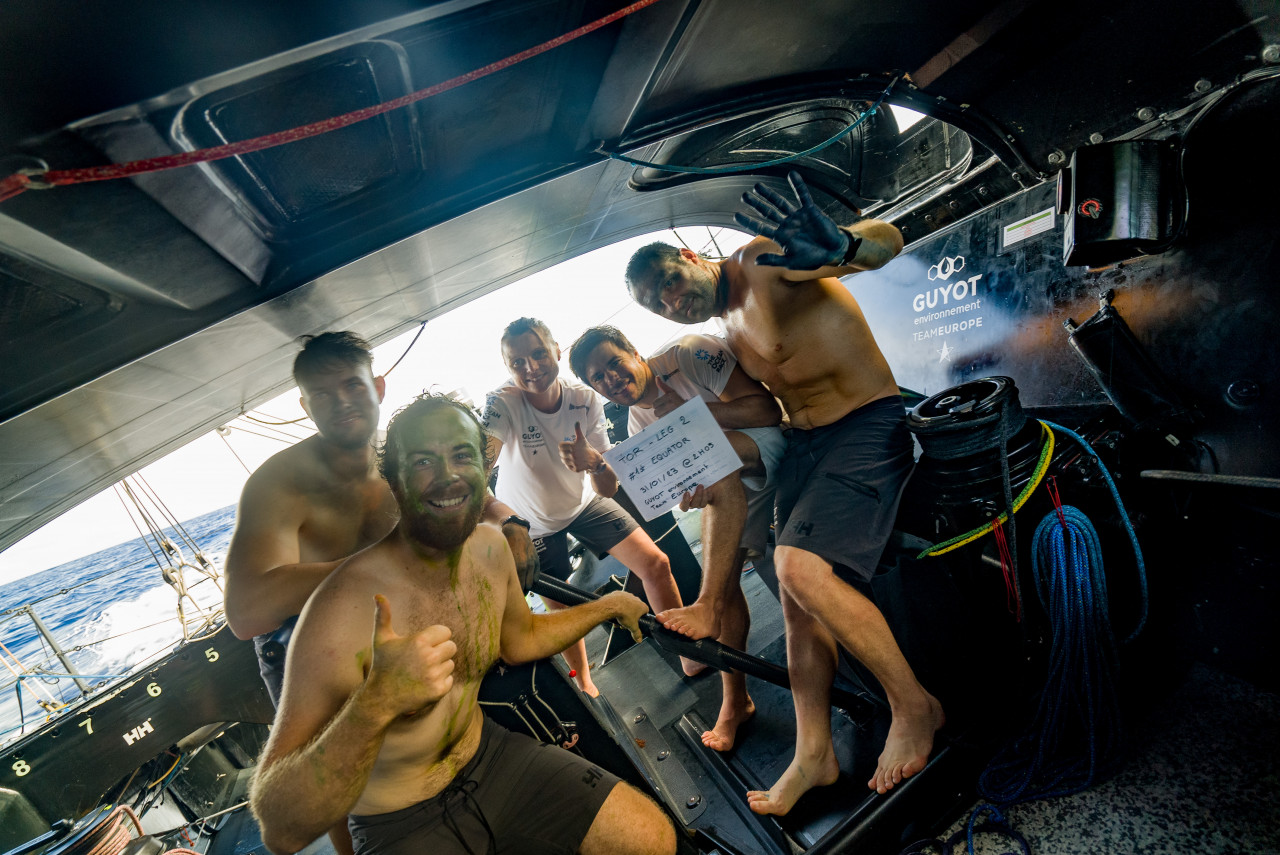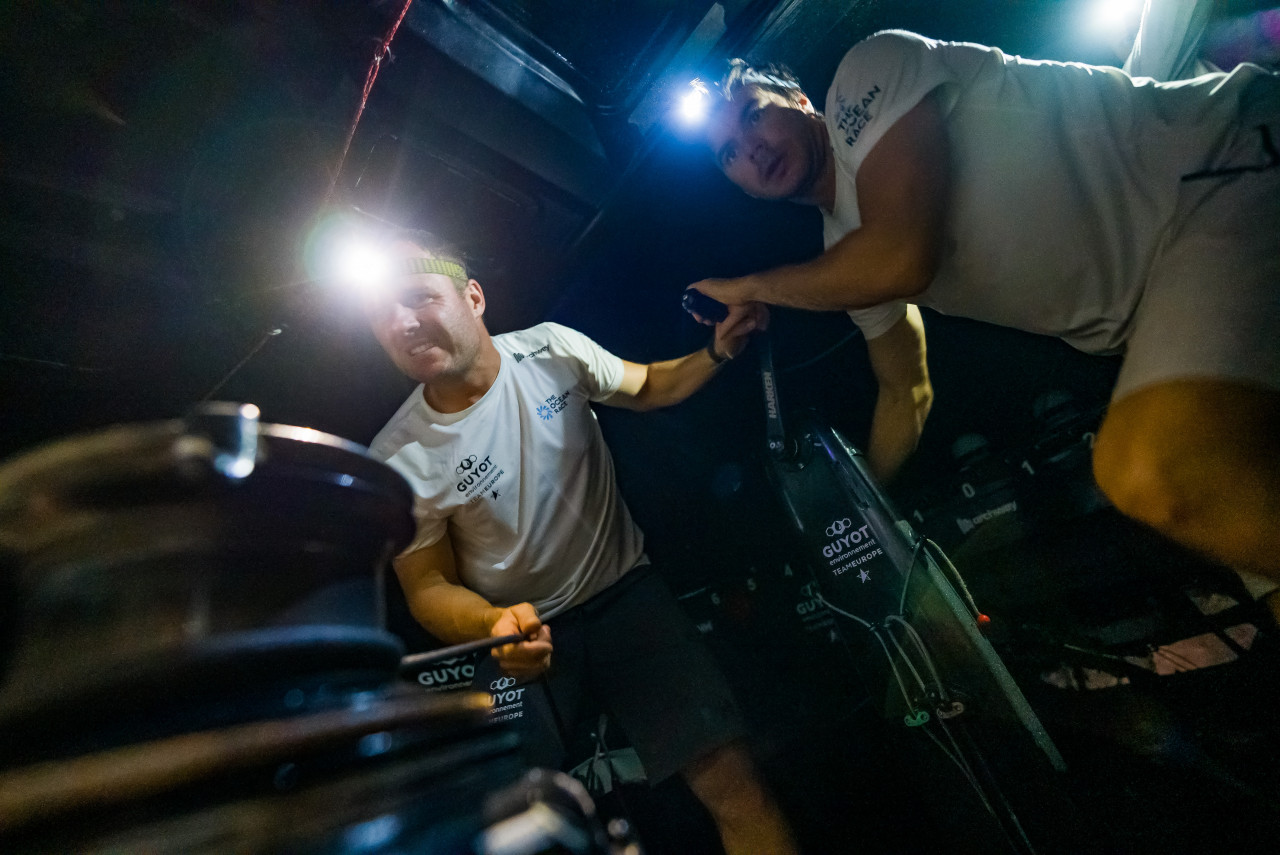Robert Stanjek: Sébastien Simon proves a master at playing the shifts in and out of the Doldrums

Not many people saw this coming, but the oldest and heaviest boat in the fleet – Guyot environnement-Team Europe – has emerged from the worst of the Doldrums with a useful lead.
On board the former Hugo Boss, the mood is one of growing confidence as the team, led on this leg by Frenchman Sébastien Simon, who is also the navigator and tactician, savours its position at the top of the leaderboard after nearly six days of leg two from Cape Verde to Cape Town.
Earlier today, Guyot environnement-Team Europe, whose crew also includes the German Olympic sailor Robert Stanjek, (skipper for this leg), his fellow countryman Phillip Kasüske and French sailor Anne-Claire Le Berre, were the first to cross the Equator as the boats picked up speed in the northerly fringes of the southeast trade winds.

The black boat was cruising along at around 13 knots of boatspeed and with an advantage over Biotherm, skippered by Paul Meilhat, of 35 nautical miles. Team Holcim-PRB skippered by Kevin Escoffier, was another seven miles back, with pre-race favourites 11th Hour Racing Team Mãlama in fourth place, 65 miles behind Guyot environnement-Team Europe. The backmarker in the west, remains Team Malizia skippered by Will Harris, which has caught up a lot during the approach to the Doldrums, but was still 105 miles off the leading pace.
Significantly, Guyot environnement-Team Europe also sailed the shortest course to get to the southern hemisphere – a total of 1,269 miles, which was six miles less than Biotherm, 135 miles less than Team Holcim-PRB, 144 miles less than Mãlama, and 231 less than Team Malizia.
In an interview from on board, Stanjek, who described Simon as “first person in charge,” talked about how the team on Guyot environnement-Team Europe has worked its way into the 4,600-mile leg after a poor start. They were initially in last place to the west of the leading bunch, as the crews made their way south from Mindelo.
“On the first night we found ourselves on the wrong side of the game, so the other boats further to the east stretched out and made some early gains with more pressure,” said Stanjek. “But we kept patient – we kept sailing and kept going – and then we sailed with the A2 on some very nice downwind angles.”
Stanjek says Simon was excellent at working the boat through variable conditions, in terms of wind angles and pressure, as Guyot caught up the lost ground. “He was very patient with oscillating persistent shifts,” he explained. “Waiting for the breeze to fill in clearly – we had like five or six gybes and made good gains, making contact with the fleet again. Then his decision was to position us a little bit easterly, inside of the competition, and we were the most easterly boat.”
To start with, Simon was worried they had picked the wrong lane, as the boats to the west, led by Meilhat’s team on Biotherm, led the way in the light and variable winds of the Doldrums. But then Guyot’s position started to pay-off. Stanjek says the crew managed to sail an efficient course to the south, compared to their rivals further west.
“Something I am very proud of, is the way the whole team made a very precise job in sailing a straight line south,” he said. “If you look at the tracker, the other boats’ lines are way more nervous than ours, with a couple of gybes and adapting angles. We were really trying hard to invest very metre in moving forward to get to the south, and I think this is probably one of the secrets about why we have now found ourselves in the lead.”
The team on Guyot environnement-Team Europe is learning all the time how to get the best out of their boat, which is eight years older than the other four in this race. Stanjek says he is trying not to fret about the fact that they might struggle to be competitive in all conditions against their newer rivals.
“Our boat is eight years older and it is a little bit heavier, so we are just sailing a different boat and we have to sail it the best way we can,” he said. “So obviously it is still a difficult race and there are still difficult adjustments to find the proper trim, and to make the good decisions on tactics and routing. You know, these boats are so complex and you have to sail them well to be good in the end, so I don’t want to get this too much in my head.”
Voir cette publication sur Instagram
The German sailor from Berlin says the thing he is missing most is contact with his family – his wife and children – but, other than that, he is loving every minute of The Ocean Race and his first crossing of the Equator. “I am very much enjoying this journey here,” he said. “For me, it is the first time sailing south, crossing the Equator, first time in the trade winds and the Doldrums – all very exciting. I am learning a lot, really learning a lot. Even though I am super-keen racer, I am coming from Olympic sailing, so basically I have never enjoyed the journey of sailing so much as I do right now.”
We asked about the style of leadership on board, comparing Simon with Benjamin Dutreux, who skippers the campaign overall. Dutreux led the team on stage one and will be back for the big one – stage three through the Southern Ocean. Stanjek says they are contrasting personalities, but equally effective.
“They are a little bit different from each other, but I enjoy sailing with both of them,” he said. “It takes some time to understand how to work together, the communication, and it also takes some time to understand when you can ask certain things, when they are probably too stressed and the best way to communicate. So it is a little bit different. Sébastien is way more rational – Ben is more emotionally driven, but they both do a good job and actually with this leg, I am very happy. We made some mistakes, but we also made a lot of very, very, good decisions. So, at the moment, we are in the lead so, yeah, Sébastien is playing a very good game.
Stanjek reminded us there is still a long way to go in this hot-weather leg to Cape Town, enough time for the early leaders – Biotherm, Holcim-PRB and 11th Hour Racing Team – to reassert themselves at the top of the leaderboard, while the crew on Team Malizia, continues its efforts to catch up.
Ed Gorman
Teams info
After a stunning 2025 season Sam Goodchild is the IMOCA Globe Series Champion for the second time
After a long season at the top of the IMOCA fleet that featured three race wins, Great Britain’s Sam Goodchild is for the second time in three years the IMOCA Globe Series Champion.
•••Quel rôle peut jouer la course au large dans la transformation du transport international ? Avec Pie…
Pour ce 10ᵉ épisode de Transitions, enregistré au Havre lors du départ de la Transat Café L'Or, nous recevons Jeremy Pochman, PDG de 11th Hour Racing, et Pierre-Antoine Morvan, responsable du pôle course au large et supe…
•••